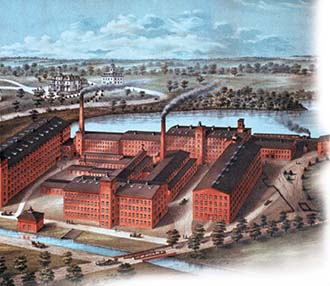transport goods from where they were made or grown to ports where they could be shipped around the world. Exports of food and goods greatly expanded the American economy. As the United States grew as a world economic power, it often clashed with the economic views and political policies of other countries.
Changing American Society
Massive changes in industry altered how Americans lived and worked. Even farms became mechanized, meaning that fewer farm laborers were needed to feed the nation. Out-of-work farmers and their families moved to urban areas to find work, especially in the increasingly industrial North. Many moved to manufacturing centers that had sprung up around growing factories or industries. The mass production of goods meant that these new urban dwellers had easy access to clothing and supplies that they would have had to make by hand in the past. Yet they faced higher costs of living, were dependent upon cash wages to buy food, and performed repetitive work in factories.
Thinking About the Environment
In the early 1800s, few worried about how industry might affect the environment. However, by the late 1800s, industrial waste had risen dramatically and mining had begun to destroy the land. In the Midwest, increasing agricultural production had led to soil erosion and dust storms. People began to raise concerns about protecting natural resources. Congress responded by setting aside protected lands that would eventually become part of the National Park Service. Its creation of Yellowstone Park in 1872 was one of the first federal responses to concerns about the environment.
![]() Checkpoint What impact did industrialization have on Americans?
Checkpoint What impact did industrialization have on Americans?

A Pleasant Scene An attractive 1879 print of a Massachusetts factory gives no hint of the pollution the factory regularly produced.
SECTION 1: Assessment
Progress Monitoring Online
For: Self-test with vocabulary practice
Web Code: nca-1311
- Terms and People For each item below, write a sentence explaining how it relates to industrialization.
- entrepreneur
- protective tariff
- laissez faire
- patent
- Thomas Edison
- Bessemer process
- suspension bridge
- time zone
- mass production
- NoteTaking: Reading Skill: Identify Causes and Effects Use your completed chart to answer the Section Focus Question: How did industrialization and new technology affect the economy and society?
Comprehension
- Quick Write: Define Your Audience Suppose that you are Thomas Edison writing a memo to J. P. Morgan requesting more financial support for work being done in your lab. Think about how much information Morgan needs to know, and summarize it in bullets.
Writing About History
- Recognize Ideologies Would you characterize all of the government’s policies in the late 1800s toward business as laissez faire? Explain your answer.
- Determine Relevance How did the system of patents encourage innovation and investment?
- Distinguish Fact From Opinion Explain why you agree or disagree with this statement: “The late 1800s was a time of great progress for all Americans.”




